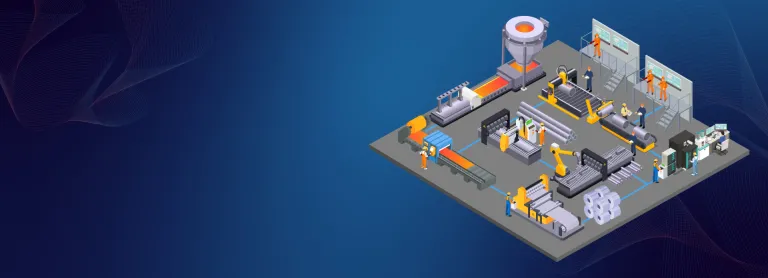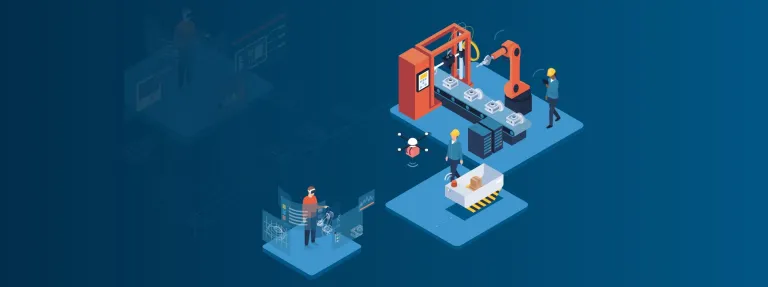Supply Chain Trends 2026
How digitalization, virtual twins, AI, and emerging technologies are shaping resilient, agile, and sustainable supply chains.
What’s New in Supply Chain Planning in 2026?
Supply chains are in a new era where disruption is the norm and agility defines success.
Trends such as artificial intelligence, virtual twins, and advanced analytics are reshaping how businesses plan, forecast, and adapt in real time.
By breaking silos and strengthening collaboration, these innovations help companies anticipate risks, test scenarios and adapt strategies in real time. This approach strengthens resilience, enables smarter decision-making, improves collaboration, and supports a sustainable balance between cost and performance.
How to Build a Resilient, Visible, and Agile Supply Chain?
Artificial Intelligence Use Cases in Supply Chain
- Sales and Operations Planning
- Production Optimization
- Inventory Planning
Sales and Operations Planning
AI and Machine Learning (ML) can be leveraged to enhance demand forecasting in sales and operations planning. By analyzing historical sales data, market trends, and external factors such as economic indicators or weather patterns, AI models can predict future product demand with high accuracy.
- Improved Accuracy: AI-driven demand forecasting reduces errors in predictions, leading to more accurate inventory management and minimizing stockouts or overstock situations.
- Enhanced Decision-Making: By providing real-time insights and predictive analytics, AI enables more informed decision-making. This helps businesses respond swiftly to market changes, improving agility and competitiveness in the marketplace.
Production Optimization
AI can be utilized to optimize master production scheduling by analyzing production data, resource availability, supply and demand. This helps in creating efficient production schedules that align with business goals and customer demands.
- Enhanced Efficiency: AI-driven scheduling can optimize resource allocation and production timelines, reducing downtime and increasing customer fulfillment levels.
- Flexibility and Responsiveness: AI models can quickly adapt to changes in demand or production constraints, allowing for more agile and responsive production planning.
Inventory Planning
AI can be applied to optimize inventory levels by analyzing sales patterns, lead times, and supplier performance. This ensures that the right amount of stock is maintained to meet customer demand without overstocking.
- Reduced Holding Costs: By maintaining optimal inventory levels, AI helps minimize excess stock, thereby reducing storage and holding costs.
- Improved Service Levels: AI-driven insights ensure that inventory is available when needed, enhancing customer satisfaction and reducing the risk of stockouts.
How Supply Chain Innovators are Redefining the Future
While the future points to autonomous supply chains powered by AI, quantum computing, and next-generation connectivity, many organizations are already laying the groundwork today. From predictive planning to virtual simulations, supply chain professionals are putting these innovations into practice—building resilience, agility, and efficiency step by step. The following success stories highlight how companies are turning vision into reality, demonstrating tangible impact across industries.
Explore a 3D model of the supply chain where you can navigate through different stages and hear real customer testimonials on critical aspects like route and resource scheduling, crew planning, workforce planning, and sales and operations planning.
Discover how each decision affects efficiency and sustainability, gaining valuable insights into optimizing operations across the supply chain.
Collaboration with Manufacturing & Engineering
Insights from a Tech-Clarity Survey on Integrated Supply Chain Planning
Facing ongoing disruption, manufacturers must overcome disconnected planning and visibility gaps by fostering stronger collaboration between supply chain, engineering, and manufacturing. Key insights from Tech-Clarity's survey of over 220 manufacturers, show the critical elements to enabling resilient, integrated operations that respond faster and deliver better business outcomes.
Tighten Collaboration with Manufacturing & Engineering
Cross-operations collaboration (planning with manufacturing, process engineering, and product design) is the #1 factor Top Performers credit for positive business impact; visibility matters, but collaboration differentiates to drive better quality, higher customer satisfaction, and faster lead times/time-to-market.
Increase Planning Cadence and Augment with AI
More frequent (even continuous) planning improves responsiveness. Top Performers use AI optimization and autonomous planning far more, and cite autonomy as the top way to minimize negative impacts from volatility. This drives faster, exception-driven decisions that reduce disruption impact while freeing people to focus where judgment matters.
Integrate Plans, Data, and Digital Twins across Horizons
Integrated plans (strategy, demand, supply, inventory, production, finance, products) enable faster, coordinated decisions. Top Performers are nearly 2× more likely to run a single integrated plan. Unified data and integrated operations (plus twins of supply chain, products and production) remove application and data silos for speed and confidence in change, translating into resilient, end-to-end planning and execution.
Commit Early and Treat Resilience as a Long-term Transformation
Top Performers started earlier and invest over time. Transforming planning for resilience is a multi-year journey. However, the returns are significant, both in quick wins (accuracy, inventory fit, demand/supply response, loyalty), and continuous benefits, including faster NPI from design to first delivery.
Future-proofing the Supply Chains through Climate Adaptation
Optimization and planning technology, including virtual twins, revolutionizes sustainable supply chain planning by enhancing visibility and operational efficiency. Virtual universes enable businesses to rapidly design, test, and optimize new products and processes, leading to waste elimination and the avoidance of physical prototypes.
With 80% of environmental impacts hidden in the value chain, real-time carbon footprint tracking becomes crucial. Virtual twins provide comprehensive insights, allowing for sustainable sourcing optimization and material recirculation, fostering a circular economy.
Integrating these technologies grants companies operational transparency, significant cost savings, and reduced CO2 emissions through optimized logistics. This ensures a competitive edge and a positive societal impact, aligning business practices with sustainability goals for a greener future.
Start Your Journey
Why Apply Supply Chain Management Trends 2026 to Your Strategy?
Ready to prepare yourself for the future of supply chains?
Try the virtual to real-world experience with exclusive access to customer stories and videos
Also Discover
Learn What DELMIA Can Do for You
Speak with a DELMIA expert to learn how our solutions enable seamless collaboration and sustainable innovation at organizations of every size.
Get Started
Courses and classes are available for students, academia, professionals and companies. Find the right DELMIA training for you.
Get Help
Find information on software & hardware certification, software downloads, user documentation, support contact and services offering




